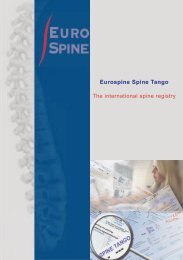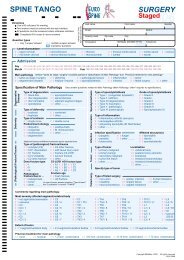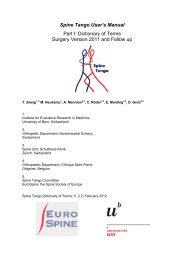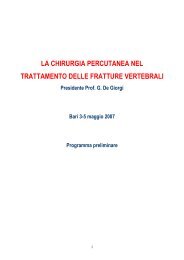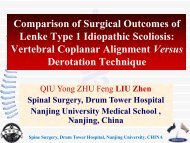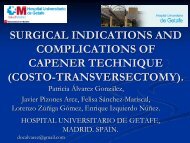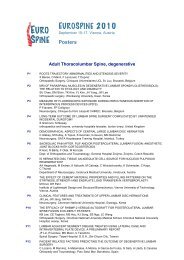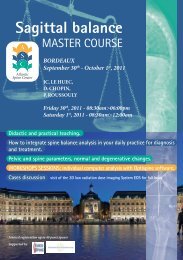Anomalous vertebral artery at the extraosseous and intraosseous ...
Anomalous vertebral artery at the extraosseous and intraosseous ...
Anomalous vertebral artery at the extraosseous and intraosseous ...
Create successful ePaper yourself
Turn your PDF publications into a flip-book with our unique Google optimized e-Paper software.
<strong>Anomalous</strong> <strong>vertebral</strong> <strong>artery</strong> <strong>at</strong> <strong>the</strong> <strong>extraosseous</strong> <strong>and</strong><br />
<strong>intraosseous</strong> regions of <strong>the</strong> cranio<strong>vertebral</strong> junction<br />
detected by 3-D 3 D CT angiography: analysis on <strong>the</strong> 100<br />
consecutive oper<strong>at</strong>ive cases<br />
Masashi Yamazaki, MD, PhD, Akihiko Okawa, MD, PhD,<br />
Tsuyoshi Sakuma, MD, Hiroshi Takahashi, MD, Mitsuhiro<br />
Hashimoto, MD, Kei K<strong>at</strong>o, MD, Masao Koda, MD, PhD,<br />
Kazuhisa Takahashi, MD, PhD,<br />
Spine Section, Department of Orthopaedic Surgery,<br />
Chiba University Gradu<strong>at</strong>e School of medicine, Chiba, JAPAN
Recent progress of instrument<strong>at</strong>ion surgery <strong>at</strong><br />
cranio<strong>vertebral</strong> junction (CVJ)<br />
Advantage<br />
Rigid internal fix<strong>at</strong>ion<br />
Complic<strong>at</strong>ion<br />
Risk of <strong>vertebral</strong> <strong>artery</strong> (VA) injury<br />
Importance of pre-oper<strong>at</strong>ive<br />
evalu<strong>at</strong>ion of VA course
Objectives<br />
In <strong>the</strong> present study, we used 3DCTA, <strong>and</strong> examined<br />
<strong>the</strong> <strong>extraosseous</strong> <strong>and</strong> <strong>intraosseous</strong> anomalies of VA in<br />
p<strong>at</strong>ients who underwent instrument<strong>at</strong>ion surgery <strong>at</strong><br />
<strong>the</strong> CVJ.
P<strong>at</strong>ients<br />
100 consecutive p<strong>at</strong>ients who submitted to<br />
instrument<strong>at</strong>ion surgery <strong>at</strong> <strong>the</strong> CVJ<br />
(1998.7 - 2009.1, Chiba Univ. Hospital)<br />
•59 p<strong>at</strong>ients: <strong>at</strong>lanto-axial sublux<strong>at</strong>ion<br />
(AAS)<br />
•41 p<strong>at</strong>ients: middle-lower cervical fix<strong>at</strong>ion<br />
including C2 was required (MLC+C2)
AAS cases (n=59)<br />
AAS/CSA: 22<br />
AAS/RA: 12<br />
AAS/dens fracture: 8<br />
AAS/unknown: 6<br />
AAS/Down syndrome: 5<br />
AAS/CP: 3<br />
AAS/trauma: 3<br />
Congenital<br />
skeletal anomaly<br />
(n=27)<br />
Os odontoideum<br />
Occipitaliz<strong>at</strong>ion of C1
Middle-lower cervical fix<strong>at</strong>ion including C2<br />
(MLC+C2) cases (n=49)<br />
Spine tumor: 11<br />
Cervical spondylosis: 10<br />
CP: 8<br />
OPLL: 8<br />
Spinal cord tumor: 2<br />
CSM+CSA: 1<br />
CSM+NF-1: 1<br />
Trauma: 1<br />
Congenital<br />
skeletal anomaly<br />
(n=1)
Total 100 cases<br />
CSA-positive cases:<br />
CSA(+)<br />
(n=28)<br />
No CSA cases:<br />
CSA(-)<br />
(n=72)
Abnormal course of VA <strong>at</strong> <strong>extraosseous</strong> region<br />
11 cases (11% of total 100 cases)<br />
Persistent 1 st intersegmental <strong>artery</strong>: 9<br />
Fenestr<strong>at</strong>ion: 2<br />
All 11 cases had CSA<br />
(P < 0.01)<br />
39.2% of 28 CSA(+) cases had abnormal course of<br />
VA <strong>at</strong> <strong>extraosseous</strong> region
<strong>Anomalous</strong> VA <strong>at</strong> <strong>intraosseous</strong> region<br />
High-Riding VA:<br />
29 cases (29% of total 100 cases)<br />
14 cases had CSA<br />
(p < 0.01)<br />
50% of 28 CSA(+) cases had high-riding VA
16y. Female, AAS/Down syndrome<br />
Os odontoideum<br />
Rt VA: Fenestr<strong>at</strong>ion<br />
(Yamazaki M, Spine 2004)
67y. M AAS/CSA<br />
C2<br />
Os odontoideum<br />
Lt VA: Persistent 1 st<br />
intersegmental <strong>artery</strong><br />
Lt<br />
High-riding VA
Conclusions<br />
In p<strong>at</strong>ients having osseous anomalies <strong>at</strong> <strong>the</strong> CVJ, <strong>the</strong><br />
frequency of anomalous course of VA <strong>at</strong> <strong>the</strong> <strong>extraosseous</strong> <strong>and</strong><br />
<strong>intraosseous</strong> regions (persistent 1 st intersegmental <strong>artery</strong>,<br />
high-riding VA) is increased.<br />
With preoper<strong>at</strong>ive 3DCTA, we can precisely identify <strong>the</strong><br />
anomalous VA, <strong>and</strong> reduce <strong>the</strong> risk of intraoper<strong>at</strong>ive VA<br />
injury in advance.<br />
No VA injury occurred.<br />
Financial Disclosure: I (or a member of my immedi<strong>at</strong>e family) do not have a financial interest or o<strong>the</strong>r<br />
rel<strong>at</strong>ionship with a commercial company or institution




